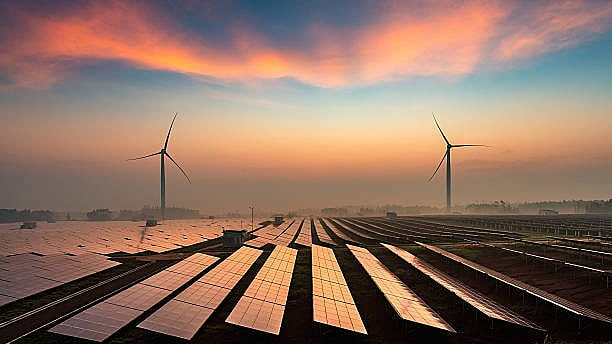
Image for representational purposes.
Credit: iStock Photo
By David Fickling
Once upon a time, the US was the sole clean energy superpower. Until 2011, it led the world in connecting wind and solar generators to the grid. Then China took over, to a point where its lead now looks unassailable: The People’s Republic added eight times more renewables than the US last year. This year, India is likely to overtake too.
The country connected 22 gigawatts of wind and solar in the first half — a dramatic recovery from a troubling slowdown in 2022 and 2023, and enough at full output to power nearly one-tenth of the grid. Assuming this is maintained through December, that should put India ahead of the 40 GW that the US government expects this year.
It’s also setting the world’s most populous nation on course to hit a target of Prime Minister Narendra Modi’s that once seemed implausible: to reach 500 GW of non-fossil generation by 2030. Such a shift will herald the dawn of a new clean energy superpower, and give the world some of its best hopes of averting disastrous climate change.
Spinning up
Credit: Bloomberg Photo
It’s a remarkable turnaround for a country whose renewable industry looked like a lost cause barely more than a year ago. What happened?
One factor is financing. Easing inflation has allowed the Reserve Bank of India to cut its policy rate by a percentage point since December to the lowest in three years. This reduces the price of renewables, which are particularly exposed to debt costs. Regulatory deadlines have also played a role: A waiver on transmission charges for wind and solar expired at the end of last month, causing developers to rush to complete their builds in time to get the financial benefit.
The end of that waiver may cause a wobble for the sector over the next year or so, but the changes will be introduced slowly. Over the balance of the decade there’s now good reason to think the recent pace can be sustained. The rash of projects breaking ground this past year means about 414 GW of clean power is already either operating or under construction, including nuclear and hydroelectric plants. That’s not far off the 500 GW target, and we’ve still got more than five years to go.
Here comes the sun
Credit: Bloomberg Photo
Industrialists are counting on it. Solar panel manufacturing has been ramping up to the point where it now runs far in excess of domestic demand, at 91 GW. With lower tariffs into the US than their rivals in China and Southeast Asia, this excess of supply might make local panel makers rare beneficiaries of President Donald Trump’s war on clean energy. That certainly seems to be the assumption of a group of US competitors, who last week sought anti-dumping measures to keep Indian products out of their market.
For many years, India had a skeptical take on the energy transition, arguing since the 1970s that poverty was a more pressing problem than protecting the environment. The difference now is that zero-carbon power is decisively cheaper than the competition. Rising incomes, meanwhile, mean the government needs to also think about the needs of roughly half a billion middle-class citizens, who worry more about where to find a good job in a clean, livable city than the basics of subsistence living.
India is still building coal-fired power plants to make sure those newly-minted urbanites don’t suffer power cuts in the middle of punishing heatwaves, but they’re not necessarily being used. Thanks to milder weather than in recent years and the rising volumes of renewables pushing it off the grid, fossil-fired power generation fell 4% in the first half relative to 2024. That’s the first time it has dropped since the Covid-19 pandemic hit in 2020, and occurred even as electricity generation rose 0.8%. Retirements of old plants mean that fossil-generation capacity has actually declined slightly so far this year.
Cleaning up
Credit: Bloomberg Photo
It’s still possible that emissions from India’s power sector won’t peak until well into the 2030s. Even so, the faster rollout of renewables, combined with declining pollution from China and the rich world, means the global picture is improving faster than you’d realize if you were focused only on the steampunk posturing in Washington.
Renewable power isn’t just cleaner — it’s cheaper, and more suited to the aspirations of the billions in the Global South who want a better, healthier life.
Rich nations like the US can afford the indulgence of a campaign against modern energy, at least until their citizens realize how badly they’re being shortchanged. It’s a fatal myopia, though. For all Trump likes to boast of energy dominance, America is falling behind on the most important energy technologies of the 21st century.